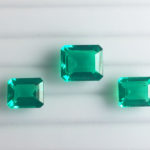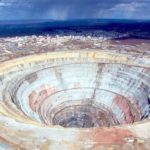Diamond Cutting
Diamonds could not be cut at all if not for the fact that the hardness of diamond is not uniform. The point of an octahedron, for example, is harder than the surface of an octahedral face. Thus, powdered diamond can cut into a diamond crystal and abrade its surface because the powder will always contain some particles oriented in a “hard” direction.
Early diamond jewels were primarily talismans, so the stones did mot gave to be polished and rough crystals were used. The art of diamond cutting originated in Venice in the early part of the 14th Century and spread to Paris and Antwerp. Today, London is the trade center for rough diamonds. From here they are sent to Antwerp. Bombay, Tel Aviv, Johannesburg, post York, San Juan, Amsterdam, and other cities for cutting. Russian-made diamonds are also appearing on the market in steadily growing numbers.
There are several steps in diamond cutting. The first gives initial shape to the stone. And is known as cleaving. Diamond readily splits in directions parallel to the octahedral faces, and cleaving rapidly removes unwanted material or separated rough into portions which are separately fashioned.
An alternative to cleaving is sawing, a step that is also useful in removing flawed areas from a diamond. A modern diamond saw is a small disc of phosphor-bronze whose edge is impregnated with diamond powder. In times past, sawing was done with a length of fine wire, a tremendously laborious and time-consuming job. It is reported that it took almost a year to saw the 410-carat Regent Diamond in half. Today the operation would require only a few days.
The next step, called bruting, consists of rounding the corners of the octahedron. This was originally done by hand with a diamond tool called a sharp, and is done today by machine. The modern equivalent of bruting is called rounding up. Small flaws can also be removed in the rounding-up process, and weight loss kept to a minimum. Occasionally a small portion of the original diamond crystal surface is left on the girdle of the stone. This area, called a natural, indicates that little material was wasted in cutting, although its presence is not desirable on a finished diamond.
After rounding up, the diamond is faceted. The table facet and the first 16 facets (eight on top, eight on the bottom) are put on by the blocker or lapper. Diamond faceting is a precision art, and the cutting wheel, which is a cast-iron lap, must be carefully balanced and running true. The diamond cutter relies on his eye to correctly proportion and finishes the stone.
Next, the brillianteerer places the final 40 facets, and polisher them. Brillianteering requires more skill than blocking, and an experienced craftsman can often correct small errors made in blocking. The final step in diamond cutting is a careful check of the work, and a thorough cleaning by boiling in acid to remove all traces of oil, dirt, and diamond powder.
The most popular diamond cut is the round brilliant, a cut often credited to a (perhaps mythical) 16th-Century Venetian lapidary named Vincenzio Perruzzi. The natural shape of the octahedron lends itself to a rounded form with a pointed bottom and flat top, but various proportions and angles could be used. Only in the 20th Century has modern perience, revealed a ser of ideal proportions and angles for extracting the maximum brilliance and dispersive color from a diamond.
In terms of diamond shapes, hexagon is the flavour of the season.Salt and pepper diamonds in hexagon shapes make for an eye-catching centerpiece as a part of an alternative engagement ring . While the characteristic speckling sets the stone apart on its own, the hexagon cute imparts a sense of synchronicity, albeit uniqueness.
Here you can large collection of different cuts and shapes of salt and pepper diamonds:
https://www.navneetgems.com/salt-and-pepper-diamonds/





